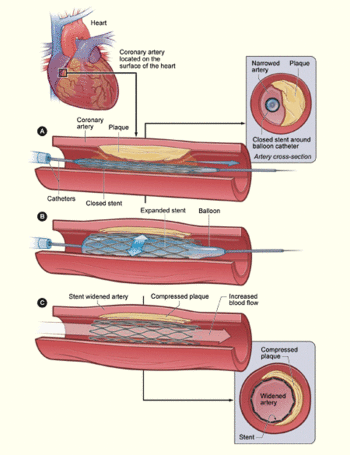Stent
A coronary stent is a small, lattice-shaped, metal tube that is inserted permanently into an artery. The stent helps hold open an artery so that blood can flow through it.[1] It is often used for patients suffering heart attacks or atherosclerosis, a condition in which the arteries become blocked due to plaque build up on the inner walls of arteries, the blood vessels that carry oxygen-rich blood throughout the body. A stent restores blood flow by acting as a permenant scaffold to hold the artery open.
Insertion
Stents are typically inserted in the femoral artery in the groin or the brachial artery in the arm and threaded up to the narrowed artery section using a balloon catheter. When the blockage is reached, the balloon is inflated to push the plaque out of the way, expanding the artery. This is referred to as [[balloon angioplasty]. Expandable stents are opened as the balloon expands, while other stents are inserted immediately after the balloon angioplasty is completed. During the procedure, contrast dye is typically running through the arterial system to guide the insertion of the stent. Following the procedure, the patient must take anti-platelet drugs to avoid thrombosis. Some stents are coated with a time released drug to prevent blod clots. Because stents are inserted into major arteries, a great deal of pressure must be applied to the insertion site to avoid excess bleeding, particularly since the patient has typically been given anti-platelet medications during the procedure.
Risks
Infection, blood clots, or bleeding may occur after stent insertion. Other rare complications of coronary stents include chest pain, heart attack, or tearing of the blood vessel. The stent can move out of place (stent migration). In some cases, plaque can reappear in the stented artery (in-stent restenosis). Drug eluting stents (DES) have additional risks which are being monitored by the FDA since their introduction in 2003-2004.
Drug eluting stents
Two drug eluting stents have dominated the market: the Taxus[2] stent from Boston Scientific and the Cypher[3] stent from Cordis, a Johnson and Johnson company. Taxus elutes the drug paclitaxel, while Cypher elutes sirolimus. Small studies have shown an increased risk, compared to bare metal stents, of stent thrombosis, cardiac mortality and mycocardial infarction, and these stents are being closely monitored by the FDA. These risks have led to prescribing Plavix for at least one year, and sometimes for life. These stents have become one of the best selling devices in medical history, and the worldwide market for drug-eluting coronary stents reached an estimated $4.2 billion in 2004 and is expected to nearly double by 2010.[4] Cypher and Taxus received FDA approval in 2003 and 2004, respectively.
